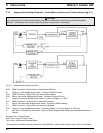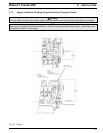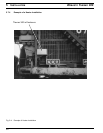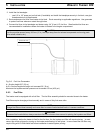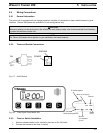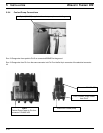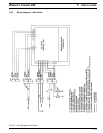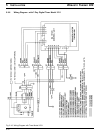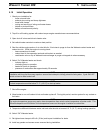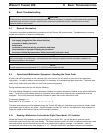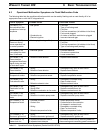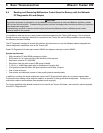
WEBASTO THERMO 300 6BASIC TROUBLESHOOTING
6-1
6. Basic Troubleshooting
6.1 General Information
This section describes troubleshooting procedures for the Thermo 300 coolant heater. Troubleshooting is normally
limited to the isolation of defective components.
6.2 Operational Malfunction Symptoms - Reading the Flash Code
A flash code will be generated on the indicator light of the control (on/ off) switch in the event of an operational
malfunction. In order to make a correct analysis it is necessary to understand the flash code event. The flash code
event is only visible during the after run (cool down) period of operation.
During the flash code event you will see the following:
Five quick flashes followed by a slower sequence of flashes, the slower sequence of flashes is the actual malfunction
code. The first five quick flashes are only an indication that a malfunction code has been registered and will be
displayed. Count only the slower sequence of flashes to obtain the current malfunction code.
For example (flashes = ¤):
Fault code 7X (F 07): ¤¤¤¤¤ ... ¤ ... ¤ ... ¤ ... ¤ ... ¤ ... ¤ ... ¤
The flash code sequence will be repeated during the Thermo 300 after run (cool down) period and will remain visible
once heater stops in the lock out mode. Once the heater is cycled “Off” and “On” the malfunction flash code will no
longer be visible on the indicator light but will be stored in memory.
6.2.1 Reading a Malfunction Code with the Digital Timer Model 1531 Installed
Where the Thermo 300 installation includes the Digital Timer model 1531, you will be able to read the current
malfunction code directly from the timer display. The flame indicator symbol will “flash” the present malfunction code
once and will then convert the malfunction code to an alphanumeric display message. For example: code 10
(overheat) will be visible on the timer display as “F 10”. Once the malfunction has been corrected, and the heater
Before troubleshooting, check for and eliminate the following defects:
• fuel supply (plugged fuel filter, kinked fuel line)
• corrosion on battery terminals
• blown fuses
• corrosion on electrical wiring, connections and fuses
• loose contacts or improper crimping on connectors
• shut down initiated by temperature limiter thermostat (automatic reset)
CAUTION
Troubleshooting requires profound knowledge about structure and theory of operation of the heater and components.
Troubleshooting and fault correction should only be performed by Webasto trained, skilled personnel unless
otherwise stated in this manual.
NOTE:
After the correction of a malfunction, a functional test must always be performed with the heater installed in its
operational position in the vehicle.
NOTE:
Coolant temperature must be below 70 °C (158 °F) before heater will start.



